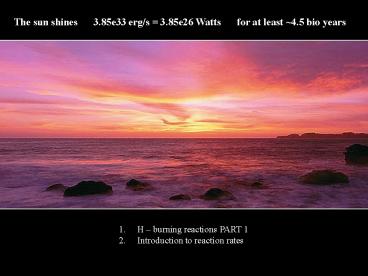The sun shines PowerPoint PPT Presentation
1 / 11
Title: The sun shines
1
The sun shines
3.85e33 erg/s 3.85e26 Watts
for at least 4.5 bio years
- H burning reactions PART 1
- Introduction to reaction rates
2
and its all nuclear physics
- 1905 Einstein finds Emc2
- 1920 Aston measures mass defect of helium (!
4ps) - 1920 Nuclear Astrophysics is born with Sir
Arthur Eddington remarks in his presidential
address to the British Association for the
Advancement of Science
Certain physical investigations in the past year
make it probable to my mind that some portion of
sub-atomic energy is actually set free in the
stars If only five percent of a stars mass
consists initially of hydrogen atoms which are
gradually being combined to form more complex
elements, the total heat liberated will more than
suffice for our demands, and we need look no
further for the source of a stars energy
3
continued history of understanding of energy
generation in the sun
1928 G. Gamov Tunnel Effect
1938 H. A. Bethe and C. L. Critchfield
The formation of deuterons by proton
combination
1938/1939 H. A. Bethe C. F. Weizaecker
CNO Cycle
H. Bethe in Michigan
4
The p-p chains
As a star forms density and temperature (heat
source ?) increase in its center
Fusion of hydrogen (1H) is the first long term
nuclear energy source that can ignite. Why ?
With only hydrogen available (for example in a
first generation star right after its
formation) the ppI chain is the only possible
sequence of reactions. (all other reaction
sequences require the presence of catalyst nuclei)
3- or 4-body reactions are too unlikely chain
has to proceed by steps of 2-body reactions
or decays.
5
pp-chains 1H ? 4He
- Step 1
- available 1H, some 4He
6
pp-chains 1H ? 4He
- Step 1
- available 1H, some 4He
pp ? d e ne
- Step 2
- available p, some d,4He
B
A
C
7
pp-chains 1H ? 4He
- Step 1
- available 1H, some 4He
pp ? d e ne
B
- Step 2
- available p, some d,4He
C
dp ? 3He
A
- Step 3
- available p, some 3He,4He little d (rapid
destruction)
D
8
pp-chains 1H ? 4He
B
- Step 1
- available 1H, some 4He
C
A
pp ? d e ne
D
- Step 2
- available p, some d,4He
dp ? 3He
14
- Step 3
- available p, some 3He,4He little d (rapid
destruction)
86 3He3He ? 2p 4He
14 3He4He ? 7Be
86
Step 4
9
pp-chains 1H ? 4He
- Step 1
- available 1H, some 4He
0.02
pp ? d e ne
- Step 2
- available p, some d,4He
14
dp ? 3He
14
- Step 3
- available p, some 3He,4He little d (rapid
destruction)
86 3He3He ? 2p 4He
14 3He4He ? 7Be
86
Step 4
14 7Be e- ? 7Line
0.02 7Be p ? 8B
10
Summary pp-chains
ppI
ppIII
ppII
8B
ppI ppII ppIII
7Be
8Be
6Li
7Li
Why do additional pp chains matter ?
3He
4He
pp dominates timescale
2
1H
2H
1
1
2
11
(No Transcript)

